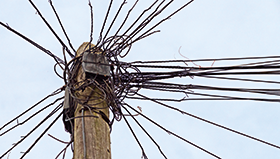

Integration is critical to estate security and is no longer a nice-to-have or a buzzword. Especially in light of POPIA and the need for fast resolution of problems (estate personnel can’t simply run around testing different systems to see what works or doesn’t).
But what does integration really mean and entail? Is it simply connecting everything to a central management system or VMS? Alternatively, does it include deeper integration between systems and people to facilitate optimised security, operations, maintenance and reliability? In addition, does it include IoT systems which may have nothing to do with security, but which provide information (or metadata) that can be collated and analysed for improved security and general operations?
“In this day and age, petty and opportunistic crime can be mitigated by the traditional safeguards,” says George Psoulis, sales manager, Africa, Milestone Systems. “In our vertical, however, we are seeing the sophistication of organised crime syndicates and the number of incidents attributed to them growing. Many estates and business are investing and relying more on smarter technology rather than physical manpower to deliver safe and secure environments.”
He continues that the importance and relevance of integration is due to the fact that devices and systems have become more intelligent and have become multi-purpose. Each system will still have a combination of both strengths and weaknesses, but by integrating systems as a value-engineered solution, it can become much greater than the sum of its parts.
“Weaknesses in one system can be compensated for by strengths in another, information from one sensor can add to information available to another totally different type of sensor, making for the ability to make smarter more accurate decisions.”
Nick Grange, managing director of XtraVision says the company has seen a large push for integrated systems, not only from the end user, but from the original equipment manufacturers. He provides the example of Arteco, which has been evolving for some time and is already known as a Video Events Management System (VEMS) as opposed to a Video Management System (VMS).
“Arteco has constantly provided Physical Security Information Management (PSIM) features which allow greater integration and more detailed reporting to assist site mangers to gather information from systems on site, both security and other systems.”

Adds Dean Sichelschmidt, Arteco Global country manager, “Moving away from integration with security only, we have the ability to integrate with IoT devices such as water flow/consumption devices. What we can do is configure ArtecoVEMS with the ability to receive readings from these devices as well as the alerts that they may generate. An example would be where the residential estate is able to get a reading of the main water feed and then get a reading from each home or apartment making use of the water. The same could be applied to the consumption of electricity.”
As far as integrating with IoT devices is concerned, Psoulis agrees, noting that non-security devices are being used for security purposes, and vice versa. “An interesting example of this is using security cameras (traditionally a video capture device) to build statistics and predictions of which entrances are busy and at what times in order to more efficiently allocate manpower, detect unusual behaviour and gather intelligence etc.”
What does integration actually mean?
Due to the nature of marketing, the actual nature of what integration actually is varies. One company may think it is integrated because it works with many of its own products, while another may allow for easy integration of third-party systems.
Psoulis admits that integration is a word that is thrown around rather loosely based on the outcome desired. In some cases it might be as simple as the single pane of glass concept where, for example, you can see live or recorded video feeds from the CCTV cameras at the same time as the personal details of a person accessing a door are presented from the access control system. He says this has its place and can improve both security and efficiency.
“Deeper integrations, such as those provided by the Milestone SDK (software development kit) allow for unlocking many more possibilities. In the same scenario as before, a deeper integration allows for licence plates captured by CCTV cameras to be to be sent to an LPR (licence plate recognition) system for processing and then passed through to an access control system in turn in the form of an additional credential to decide whether or not to grant entry or exit. In simple terms, this scenario means that if a stolen vehicle attempts to leave, the exit gate will not open because the access card or fingerprint that is expected to be associated to the vehicle isn’t present as well.”
There are two ways we can integrate systems, says Grange, dependnt on type of integration required. “The traditional I/O integration method allows for an Input or Output to be displayed on the Arteco VEMS and call an associated action. The advantage of this is that when new software patches are released, it has no effect on integration to third-party systems. The second option would be via SDK or Open Connector. This would entail software being written to transfer information between the system over the TCP/IP network; this is seamless and allows for more information to be passed between systems, however, when upgrades and updates are done, compatibility testing needs to be done before implementation.”
Can cloud services make things simpler and cheaper?
The drive to push cloud computing in its various forms as the standard computing model around the world is no secret to anyone involved in technology, even for end users on the periphery of technology. The marketing blurb will tell us that cloud is cheaper and easier, and services make everything simpler. Does this hold for the security integrations required in estates in Africa?
Grange says, “I do not believe South Africa is ready for a full cloud-based solution right now, however this is the future. The reason we are not ready is our data networks are not fully geared for this and should there be a huge uptake, our networks and uplink speeds to data centres would bottleneck, thus causing the hosts to levy a surcharge for these services to try and discourage this practice.
“We feel there are advantages to having systems situated onsite and that the compromise will be a hybrid system with hardware onsite and events being sent to the cloud for analysis and capture.”
Sichelschmidt supports this, noting that Arteco is cloud-ready, but is pushing development in three directions in this respect: the traditional on-premises server/client model, hybrid models, and also a pure cloud-based offering.
Psoulis agrees that cloud is starting to offer more exciting opportunities with the ability to use resources on demand. The benefit is often you only pay for the time they are in use. “Milestone has integrations into the cloud with an option to host your entire system there, but also to make use of solutions from partners that offer some really interesting analytic opportunities on a pay-as-you-use basis.

He also notes that, at present, we are still seeing a journey to cloud and that it is not possible for everyone to make an immediate transition. Apart from the well-known bandwidth issues locally, many customers prefer a Capex model and they want to purchase and own their assets outright.
“There is a middle ground for those interested in exploring the cloud option without fully committing, this is what is known as ‘fog computing’,” he adds. “In this scenario the intelligence is distributed closer to the edge, decisions can be made at the source on premises, and then only transmitted to the cloud if required rather than constantly transmitting 24x7. This saves on the amount of bandwidth that is required, but also saves on costs as intelligent devices are able to handle a lot of the computational load that would otherwise require expensive server resources.”
Addressing the technical issues of integration
Talking about integration is one thing, but as those who have done the hard work before know, it is not always as simple as connecting two wires. Actually, it is never that simple. As mentioned above, there are different ways systems can be integrated, each with pros and cons. The issue for estates is not really the technicalities involved, but rather the outcome. An estate wants their security to be reliable, deliver the value desired, and most importantly, streamline the provision of the security service by assisting the personnel involved and optimising their productivity and performance.
Integration can be done at a higher level, relying on a system such as a VMS to automatically integrate cameras, access control readers, alarms and so forth, or at a lower lever via APIs and SDKs.
Psoulis says Milestone does both. “We have many integrations that have been developed in-house and employ a custom integration team that is able to personalise any solution as per a customer’s specific requirements. A great many of the integrations have been developed by our technology partners directly, however, which is made possible by the fact that our SDK is free of charge and available to everyone.
“If a customer would like to do their own development for use in-house, they are welcome to and even if they want to produce a product they can bring to market, we encourage that as well. Milestone does not charge any fees for bringing in solutions developed using our SDK. We also actively promote integrations and products that have met our quality standards on our Marketplace and offer this free of charge.”
Theuns van Schalkwyk, technical director of XtraVision notes that the company, as a project-based distributor, understands the end user and integrator requirements and helps facilitate the integration process. “We have successfully assisted in various hardware and software integrations, the latest of which was the software integration of a thermal radar product into Arteco for one our South American clients.”
Sichelschmidt adds that Arteco’s Open Connector makes integration very easy. “There are cases where Arteco is asked to do the integration, which is not an issue for us, but we do ask for the opportunity to first demonstrate the ease of integration by means of Open Connector. It has been really appreciated by our partners, but we wish to increase the range of integrated systems and offer an alternative method, such as APIs, and that’s why we are already working on being able to easily embrace as many solutions as possible.”
While the need for integrated solutions is obvious, we can see that service and systems providers are working to ensure that the process can be as simple and easy as possible. Not that it is a simple process, especially now that the adoption of IoT devices is and will add thousands, if not millions of new systems and devices to the market that need to, at a minimum, communicate with other devices and systems, and more likely, will need some type of deeper integration.
For the residential estate, the need for integration should be part of their security thinking from the initial planning phase. This will ensure that the full security solution can be managed centrally, and that systems and platforms are chosen that make it as simple as possible to integrate new solutions that come to market, no matter which vendor produces them and whether they are security-related or not. The age-old requirement for open systems and open collaboration with other vendors is key to the security technology decisions estates make to allow them to layer their security solution as they see fit, instead of adding layers of complexity in their control rooms and the personnel who will have to do daily battle with technology.
| Tel: | +27 10 500 8793 |
| Email: | [email protected] |
| www: | www.milestonesys.com |
| Articles: | More information and articles about Milestone Systems |
| Tel: | +27 11 450 1056 |
| Email: | [email protected] |
| www: | www.xtravision.co.za |
| Articles: | More information and articles about XtraVision |
| Tel: | +27 11 543 5800 |
| Email: | [email protected] |
| www: | www.technews.co.za |
| Articles: | More information and articles about Technews Publishing |
| Tel: | +27 81 443 8583 |
| Email: | [email protected] |
| www: | www.arteco-global.com |
| Articles: | More information and articles about Arteco Global Africa |

© Technews Publishing (Pty) Ltd. | All Rights Reserved.